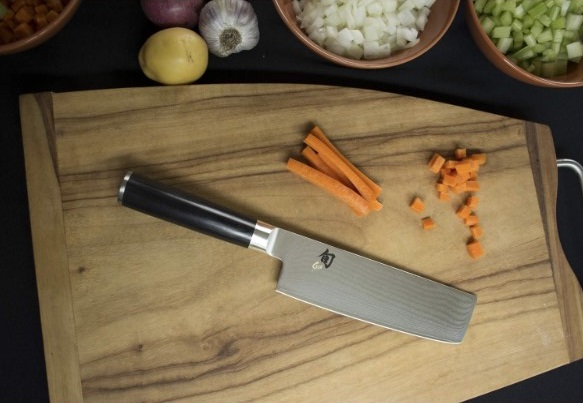Nakiri vs Santoku: two iconic Japanese kitchen knives, each with its distinct purpose and design. While the Nakiri is renowned for its vegetable precision cuts, the Santoku is a versatile player, adept at slicing, dicing, and mincing. The choice between these knives often boils down to personal preference and the specific culinary task at hand. Yet, by delving deeper into their features and benefits, one can make an informed decision tailored to individual cooking endeavors.
In the intricate world of kitchen tools, the debate around Nakiri vs Santoku has garnered considerable attention. Both knives hail from Japanese culinary traditions, boasting unique designs and specific functionalities. The Nakiri, characterized by its thin, rectangular blade, is a vegetable maestro, excelling in precision cuts. On the other hand, the Santoku, with its distinct curved tip, is an all-rounder, adept at various tasks from slicing to chopping. Choosing between these two is not merely a matter of aesthetics but understanding their strengths and aligning them with one’s kitchen tasks. Delve into this guide to determine which blade resonates with your culinary journey.
Nakiri vs. Santoku Comparison
When it comes to Japanese kitchen knives, two names often stand out: Nakiri and Santoku. These two knives, while originating from the same country and having certain similarities, serve distinct purposes and offer unique features that can greatly influence your culinary experience.
Nakiri: The Basics
The Nakiri knife, also known as ‘nakiri bocho’, originates from Japan and is primarily used for chopping vegetables. The word ‘nakiri’ can be translated to ‘vegetable cutter’, and the design of this knife clearly reflects its purpose.
Its blade is straight and thin, which allows for clean, precise cuts. Typically, a Nakiri knife measures between 5 to 7 inches in length. One of the most distinguishable features of the Nakiri is its flat bottom, which ensures that every part of the blade touches the cutting board, leading to uniform and consistent slices.
Santoku: The Basics
Santoku, on the other hand, is often referred to as the ‘three virtues’ knife. This name stems from its versatility in handling three primary tasks: slicing, dicing, and mincing. Unlike the Nakiri, the Santoku has a slightly curved blade profile, which can measure anywhere between 5 to 8 inches.
The Santoku knife often features a ‘Granton edge’ or hollow ground indentations along the blade. This design helps to prevent food from sticking onto the blade while cutting.
Key Differences
Purpose and Usage: While both knives can handle vegetables efficiently, the Nakiri is specifically designed for this task. Its flat bottom ensures that you can easily chop vegetables with precision. The Santoku, being a more versatile tool, can manage meats and fish as efficiently as it handles vegetables.
Blade Design: The blade of the Nakiri is straight, while the Santoku has a slightly curved blade. This curve in the Santoku allows for a rocking motion during cutting, which can speed up tasks like mincing.
Blade Surface: Many Santoku knives come with a Granton edge, which minimizes food sticking. Nakiri knives usually have a smooth blade surface.
Length: While both knives can range between 5 to 8 inches, Nakiri knives tend to be on the shorter end, whereas Santokus can sometimes be slightly longer.
Advantages of Using Nakiri
Efficiency: Its straight edge and flat bottom make the Nakiri incredibly efficient for chopping vegetables, ensuring every piece is of the same size.
Precision: The thin blade allows for intricate cuts, making it perfect for tasks that require a high level of accuracy.

Advantages of Using Santoku
Versatility: It can handle a broader range of tasks, from slicing meats to mincing herbs.
Speed: The slightly curved blade permits a rocking motion, which can significantly speed up some cutting tasks.

Which One Should You Choose?
Your choice between a Nakiri and a Santoku largely depends on your culinary needs. If you primarily chop a lot of vegetables and want a knife dedicated to this task, the Nakiri is your best bet. Its design ensures uniform vegetable slices, which can be crucial for dishes that require even cooking.
However, if you’re looking for a more versatile tool that can handle a wider range of tasks, the Santoku is a better option. It’s especially beneficial for those who don’t want to switch between different knives while preparing a meal.
Conclusion
Both the Nakiri and Santoku are exceptional tools in their own right. Your choice should align with your cooking habits, the dishes you frequently prepare, and your personal preference in handling. No matter which you choose, ensure that you maintain its sharpness and take proper care to enhance its longevity and performance. And, as with any tool, practice will make you more proficient over time.
In the event that you found this article to be beneficial, I would like to recommend a few of our other articles that might be of further assistance to you:

Martin Flowers, a culinary enthusiast and innovator, spearheaded the creation of Best Knife For Chopping Vegetables. With a passion for precision in the kitchen, Martin recognized the need for a dedicated platform to guide chefs and home cooks alike. His expertise in cutlery, combined with a fervor for culinary arts, has made his website the go-to resource for knife enthusiasts. Whether you’re a professional chef or just starting out, Martin’s commitment ensures you have the best tool in hand.
